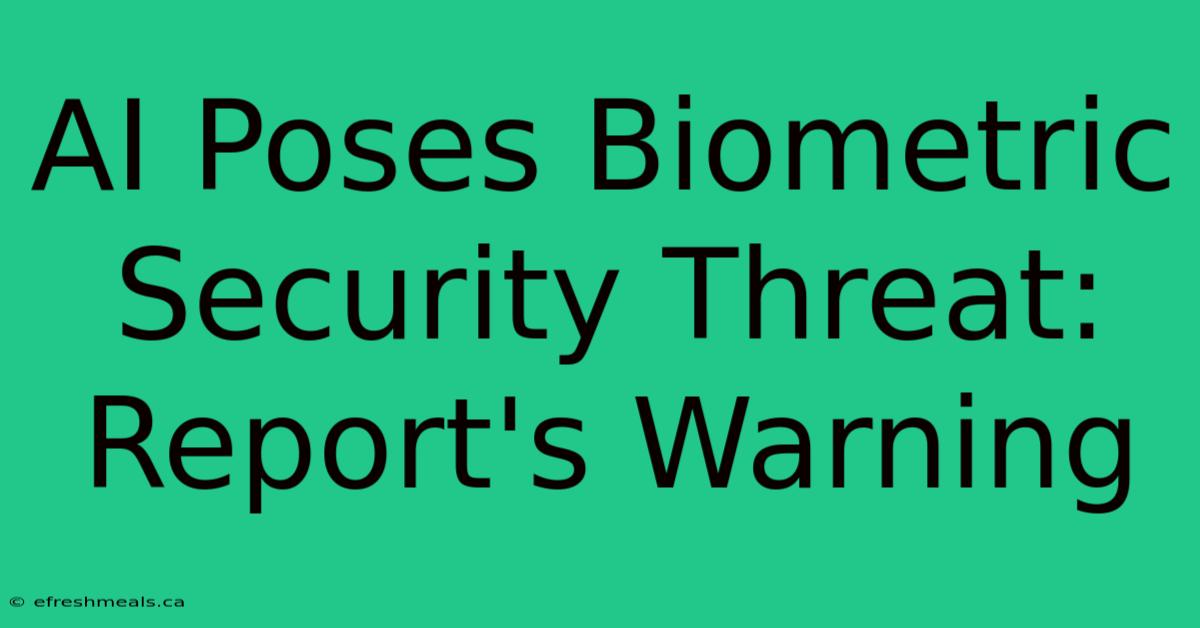AI Poses Biometric Security Threat: Report's Warning

Discover more detailed and exciting information on our website. Click the link below to start your adventure: Visit Best Website nimila.me. Don't miss out!
Table of Contents
AI Poses Biometric Security Threat: Report's Warning
Is your face, fingerprint, or iris scan truly secure in the age of artificial intelligence? A recent report warns that AI is emerging as a significant threat to biometric security systems, raising serious concerns about the future of identity verification.
Why It Matters: Biometric authentication is rapidly becoming the standard for identity verification, with applications ranging from unlocking smartphones to accessing sensitive data. This reliance on biometrics has led to the development of sophisticated AI-based systems that analyze and verify our unique biological traits. However, the rise of AI also brings with it the potential for malicious actors to exploit these systems.
Key Takeaways of Biometric Security:
| Key Takeaway | Explanation |
|---|---|
| AI-powered spoofing: AI can generate highly realistic synthetic images and videos, capable of fooling biometric systems designed to recognize faces, irises, and fingerprints. | The report highlights instances where AI-generated deepfakes have successfully bypassed facial recognition systems, posing a significant threat to security. |
| Data privacy concerns: The collection and storage of vast biometric datasets pose substantial risks, as these data can be easily stolen or misused by unauthorized parties. | The report emphasizes the need for robust data protection mechanisms to prevent unauthorized access and misuse of sensitive biometric data. |
| Ethical implications: The use of AI in biometric security raises ethical questions about potential biases, discrimination, and the impact on individual privacy. | The report calls for ethical considerations in AI development and deployment, ensuring fairness and responsible data usage. |
AI in Biometric Security
The increasing integration of AI into biometric security systems offers both opportunities and challenges. AI can improve the accuracy and efficiency of biometric authentication, leading to more secure and user-friendly experiences. However, the same AI capabilities can be exploited by malicious actors to create synthetic data and circumvent security measures.
Deepfakes and Biometric Spoofing:
Deepfakes are synthetic media that can be generated using AI algorithms to convincingly portray individuals in fabricated scenarios. These fabricated videos and images can be used to fool biometric systems designed to recognize faces, posing a significant risk to identity verification systems.
Data Privacy Risks:
The collection and storage of biometric data raise significant concerns about data privacy and security. Large datasets containing facial features, iris scans, or fingerprints can be valuable targets for hackers and cybercriminals. Unauthorized access to such data could lead to identity theft, financial fraud, and other forms of cybercrime.
Ethical Considerations:
The use of AI in biometric security raises ethical considerations, including the potential for biased algorithms, discrimination based on race or ethnicity, and the erosion of individual privacy. It is essential to develop and deploy AI systems in a responsible manner, ensuring fairness, transparency, and ethical data usage.
FAQ
Q: How can we mitigate the threats posed by AI to biometric security?
A: Implementing robust security measures, such as multi-factor authentication, encryption, and access controls, is crucial. Additionally, developing AI systems with built-in defenses against deepfakes and other forms of spoofing is essential.
Q: What are the long-term implications of AI-powered biometric security threats?
A: The widespread adoption of AI-powered biometric security systems will likely lead to an arms race between security developers and malicious actors. Constant innovation in both defense and attack technologies will be crucial to maintain a secure environment.
Q: What role can governments and regulators play in addressing these concerns?
A: Governments and regulatory bodies have a critical role in establishing guidelines and regulations for the ethical use of AI in biometric security. This includes promoting data privacy, transparency, and accountability in the development and deployment of these systems.
Tips for Securing Biometric Data:
- Use strong passwords: Employ strong and unique passwords for all online accounts, including those that utilize biometric authentication.
- Enable two-factor authentication: Utilize two-factor authentication whenever available, requiring an additional verification step beyond your biometric data.
- Avoid sharing sensitive information: Be cautious about sharing your biometric data, especially on untrusted websites or applications.
- Stay informed: Keep up-to-date on the latest security threats and vulnerabilities related to biometric systems.
Summary of Biometric Security:
The integration of AI into biometric security systems offers both opportunities and challenges. While AI can enhance accuracy and user experience, it also presents new risks associated with data privacy, deepfakes, and ethical considerations. A proactive approach to securing biometric data, promoting ethical AI development, and staying informed about evolving threats is crucial to ensure the safety and integrity of biometric authentication systems.
Closing Message: The future of identity verification depends on finding a balance between the convenience of biometric security and the need for robust security measures. As AI continues to evolve, so too must our approaches to safeguarding sensitive biometric data.

Thank you for visiting our website wich cover about AI Poses Biometric Security Threat: Report's Warning. We hope the information provided has been useful to you. Feel free to contact us if you have any questions or need further assistance. See you next time and dont miss to bookmark.
Featured Posts
-
Bell Votes Smith Secures Overwhelming 91 5
Nov 03, 2024
-
Kamala Harris Surprises On Snl
Nov 03, 2024
-
Ais Impact On Education News E Commerce
Nov 03, 2024
-
Kaine Makes Surprise Snl Appearance
Nov 03, 2024
-
Danielle Smith Gets Ucp Member Nod
Nov 03, 2024
